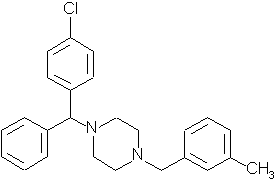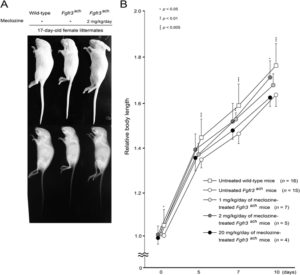Infigatinib is a potential alternative to Vosoritide to increase height during development. FGFR3 reduces growth in everyone it just does so in a greater manner in people with dwarfism as they have a mutation. CNP may have other beneficial effects on top of inhibiting FGFR3 but this just seems to be an FGFR3 inhibitor.
“Fibroblast growth factor receptor 3 (FGFR3) gain-of-function mutations play a crucial role in achondroplasia (ACH), thanatophoric dysplasia (TD), and hypochondroplasia (HCH).{But FGFR3 may decrease height in everyone during development just to a lesser degree if you have the mutation}. HCH is a less severe form of dwarfism than ACH, but similarly is caused by gain-of-function mutations in the FGFR3 gene. HCH is characterized by a disproportionate short stature and a growth deficit affecting both endochondral and intramembranous ossification. While multiple therapeutic strategies are being tested for ACH, currently there are no approved therapeutic options for individuals with HCH. We tested the hypothesis that the oral, selective FGFR tyrosine kinase inhibitor (TKI) infigratinib (BGJ398) could improve the HCH phenotype and improve endochondral and intramembranous ossification in a preclinical mouse model of HCH Fgfr3N534K/+.
The first Hch mouse model studied expresses the most frequent human mutation p.Asn540Lys (Fgfr3Asn534Lys/+), and exhibits a mild dwarfism and most of the hallmarks of the human pathology. Fgfr3N534K/+ mice received subcutaneous injections of infigratinib or vehicle control every 3 days (1 mg/kg) or daily (1 mg/kg) for 15 days (post-natal day [PND] 4–19) or 21 days (PND 3–24), respectively.
Fgfr3N534K/+ mice treated with 1 mg/kg infigratinib every 3 days did not show obvious and significant modification of the dwarf phenotype. In contrast, Fgfr3N534K/+ mice treated with 1 mg/kg infigratinib daily for a total of 21 days showed a statistically significant increase in appendicular and axial skeletal measures. Length of the long bones was statistically significantly increased in Fgfr3N534K/+ mice compared with Fgfr3+/+ mice (tibia +3.18%, femur +3.16%, humerus +3.04%, ulna +2.94%, radius +3.01%). Treatment also modified the skull shape (skull width, skull height, nasal bone length and naso-occipital length), the length of the mandible and skull base, as demonstrated by measurement of the foramen magnum (foramen magnum length +3.72%). Infigratinib treatment modified the cartilage growth plate organization, in particular the hypertrophic chondrocyte area. Finally, the high activation of the MAP kinase pathway due to the HCH missense FGFR3 mutation was reduced by treatment, as revealed by the immunolabelling of phosphorylated Erk1/2 proteins.
Treatment with daily 1 mg/kg infigratinib improved the length and weight of Fgfr3N534K/+ mice and significantly modified the skull and the axial and appendicular skeleton. We demonstrated in Fgfr3N534K/+ mice that infigratinib is able to counteract the constitutive activation of FGFR3 due to the heterozygous N540K mutation localized in the tyrosine kinase 1 domain of the protein. These results provide a rationale for targeting FGFR3 with a specific TKI for the treatment of children with HCH.”
So basically infigratinib works to increase height in people with dwarfism but given everyone has FGFR3 receptors it could help increase height in anyone with growth plates to a lesser degree.
“– In the highest dose level (Cohort 5, 0.25 mg/kg once daily), the mean change from baseline in annualized height velocity (AHV) at six months was +3.03 cm/yr (p = 0.0022) for the first 10 children with at least six months of follow-up in Cohort 5. The two remaining children who have not yet had six months of follow-up have a mean change from baseline in AHV of +8.8 cm/yr based on three months data“<-this is huge but again for normal children the gain will be smaller.
“80% of children at six months were responders, as defined by an increase from baseline AHV of at least 25%. The mean change from baseline in AHV of responders was 3.81 cm/yr“<-but that does not mean the 20% who weren’t responders didn’t get additional height at all.
” Infigratinib is an oral small molecule designed to inhibit FGFR3 and target achondroplasia at its source”
“Combined with the previously reported Cohort 4 change from baseline in AHV value of +1.52 cm/yr, the Cohort 5 data demonstrate a strong dose response for infigratinib”<-meaning the more of it you take the better but there is usually a better of diminishing returns…


